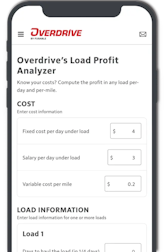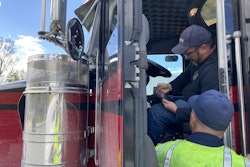Following Transportation Secretary Sean Duffy’s announcement Monday of the launch of two hours-of-service-related pilot programs to kick off National Truck Driver Appreciation Week, the Federal Motor Carrier Safety Administration on Tuesday unveiled details of what those programs could look like:
- The Flexible Sleeper Berth Pilot Program would allow participants to utilize more split-sleeper berth options, including a 5/5-hour split, in addition to the currently allowed up to 7/3-hour splits
- Split Duty Period Pilot Program: Allowing truck drivers to pause their daily 14-hour clock for between 30 minutes and three hours each duty cycle
“Truck drivers are the backbone of our economy, and we owe it to them to explore smarter, data-driven policies that make their jobs safer and more enjoyable,” Duffy said Monday. “These pilot programs will help identify real solutions for America’s drivers without compromising safety.”
Each pilot program, as proposed, would be limited to approximately 256 participating drivers.
[Related: Regulators, industry celebrate appreciation week with HOS flexibility emphasis, events, deals]
Flexible Sleeper Berth
FMCSA’s proposal to allow increased split-sleeper berth flexibility within the hours of service, which will publish in the Federal Register at this link Wednesday, Sept. 17, would allow FMCSA “to assess whether additional flexibility in how sleeper berth time may be split achieves a level of safety equivalent to that which would be achieved absent the regulatory relief.”
The agency said drivers selected to participate would provide FMCSA with data for a four-month period, divided into a “baseline” period of one month, during which they would comply with the current sleeper berth regulations, and another period of three months when they would operate under an exemption allowing additional flexibility in how they can split their sleeper berth time.

The sample of participants would incorporate drivers from small, medium and large carriers, including owner-operators.
As proposed, participating drivers would receive a study-provided smartphone installed with data collection applications necessary for the research, such as fatigue measurement apps, survey apps, etc., FMCSA said. These would not include any automated data collection applications that collect and record information without the driver’s consent. Drivers would also receive a wearable smartwatch.
At a minimum, FMCSA would gather the following data during the study:
- Records of duty status (RODs, or logs) prepared using an electronic logging device, to evaluate participants’ use of the split duty period exemption.
- Roadside inspection data and crash records.
- Wrist actigraphy data, to evaluate total sleep time, time of day sleep was taken, and sleep quality, e.g., sleep latency and intermittent wakefulness.
- Psychomotor Vigilance Test (PVT) data, to evaluate drivers’ behavioral alertness/effects of fatigue, based on reaction times. (PVT is also sometimes referred to as a Psychomotor Vigilance Task.) For this study, drivers would be required to complete daily iterations of a brief PVT, a three-minute behavioral alertness test that measures drivers’ alertness levels by timing their reactions to visual stimuli.
- Subjective sleepiness ratings, using the Karolinska Sleepiness Scale (KSS), to measure drivers’ perceptions of their fatigue levels.
- Survey data (driver pre- and post-study surveys to provide contextual information).
- Other information necessary to complete the analyses may be collected through the participating motor carrier. Every effort will be made to reduce the burden on the motor carrier in collecting and reporting this data.
[Related: Significant hours of service change: FMCSA's 2020 split-sleeper provision changes, explained]
FMCSA acknowledged that there is potential under the pilot program “for employing motor carriers, shippers, and receivers to pressure participating drivers to use the exemption in a manner which benefits their business needs but not the driver’s own schedule, restfulness, and safe driving behavior.” The agency said that’s not its intention for the program, adding that it will “actively monitor and watch for any indication that shippers, receivers, or employing motor carriers are inappropriately influencing or misusing a driver’s ability to determine how and when to utilize the flexibility provided by the exemption.”
FMCSA also detailed the proposed requirements for participation for both motor carriers and drivers. As proposed, participating motor carriers are required to meet the following criteria:
- Must have proper operating authority and registration
- Must have the minimum levels of financial responsibility, if applicable
- Must not be a high or moderate risk carrier
- Must not have a conditional or unsatisfactory safety rating
- Must not have any enforcement actions within the past three years
- Must not have a driver out of service (OOS) rate above 5.97%
- Must not have a vehicle OOS rate above the 21.41%
Unpaid civil penalties could also be grounds to be disapproved from participating, FMCSA added.
[Related: Sleeper berth: Should more truckers be able to split as they see fit?]
For drivers, would-be participants would not be eligible if, during the two-year period immediately preceding the date of participation, the driver had his or her license suspended, revoked, cancelled, or has been disqualified for a conviction of one of the disqualifying offenses listed in §383.51. In addition, drivers would be required to:
- For the purposes of the study, operate the same CMV (equipped with a sleeper berth) as operated for their main source of employment and regularly use the sleeper berth
- Possess a valid CDL
- Maintain a valid medical certificate from a healthcare professional on the agency’s National Registry of Certified Medical Examiners while participating in the pilot program
- Be employed by a motor carrier who has been approved for participation in the pilot program and/or certify as an owner-operator
- Agree to comply with the study procedures, including the use of a wearable actigraph, the completion of tests/surveys related to fatigue/sleepiness, and the preparation of RODS using an electronic logging device
FMCSA clarified that data collected will be transferred to third-party researchers, who will not transfer any of the data or information to FMCSA. Therefore, it will not be used by FMCSA for the purposes of enforcement actions against a participating motor carrier or driver.
The agency will accept public comments on the proposed pilot program for 60 days following the notice’s publication in the Federal Register Wednesday. Comments can be filed here through Nov. 17. FMCSA has listed several areas it seeks information about in the proposal, which can be found here, but responses don’t have to be limited to those questions.
[Related: Industry details challenges to House subcommittee]
During the first Trump administration in 2017, FMCSA also proposed a pilot that would have tested different split-sleeper options. In this week's proposal, the agency said when developing its HOS notice of proposed rulemaking in 2019, which led to significant hours changes the following year, "FMCSA elected to not pursue the 'flexible sleeper berth pilot program' at that time, instead using the HOS NPRM to ask the public whether data already existed on the '6/4' or '5/5' splits."
FMCSA said no data was provided in response to that NPRM, yet "the need remains for additional flexibility in how drivers may comply with the hours-of-service regulations," which is why the agency is moving forward with the pilot program today.
Split Duty Period
In the other proposed pilot program, also publishing Wednesday in the Federal Register, participating truck drivers would have the option to extend their 14-hour on-duty period by taking one off-duty, sleeper berth, or on-duty/not driving period (taken at the location of a pick-up or delivery of cargo), including what is sometimes called “detention time,” of no less than 30 minutes and no more than three hours.
FMCSA said it “believes that the exemption covered by the proposed pilot program provides the flexibility to take extra rest, avoid driving during traffic congestion, and mitigate the impacts of unreasonable ‘detention times,’ thereby improving the working conditions of America’s truck drivers.”
As with the sleeper berth flexibility pilot program, FMCSA acknowledges that there is potential for motor carriers, shippers and receivers to pressure drivers into extending their duty period “to justify existing or further delays in loading or unloading.”
The agency said during the proposed pilot program, it would track the type of duty status participating drivers use to extend their 14-hour clock, which will help FMCSA in estimating the extent to which detention time occurs, as well as its potential effects on driver fatigue and safety performance metrics compared to pauses taken under other circumstances.
FMCSA will also “actively monitor and watch for any indication that shippers, receivers, or employing motor carriers are inappropriately influencing or misusing a driver’s ability to determine how and when to utilize the flexibility provided by the exemption,” the agency noted.
[Related: Parties other than motor carriers now subject to FMCSA jurisdiction under the coercion rule]
In addition to providing relief from detention time, FMCSA also believes the ability to pause the 14-hour clock could allow drivers to avoid congestion, thereby giving them an increased opportunity to travel at posted speed limits than below them during heavy congestion. The agency also said the flexibility could reduce pressure to drive at speeds higher than posted speed limits. Finally, FMCSA said drivers would have the ability to pause the clock to take a break to reduce the likelihood of driving while fatigued.
Under the proposed program, any on-duty/not driving time (taken at the location of a cargo delivery or pickup) used to extend the driver’s 14-hour clock would continue to count against the 60-/70-hour on-duty time limits in a 7- or 8-day period. However, any off-duty or sleeper berth time used to extend the driver’s 14-hour window would not count against the 60/70-hour limit.
Additionally, drivers would still be required to have 10 consecutive hours off-duty or in the sleeper berth at the end of the shift and continue to be limited under the 60/70-hour rule.
The split duty period pilot would also last four months per participating driver with one month of data collection under “baseline” conditions under current regulations, and three months of operating under the exemption. Participants will receive a smartphone with the necessary data collection apps, along with a smartwatch.
Information collected for this pilot would be the same as for the split sleeper pilot, detailed above.
Additionally, requirements for motor carriers and drivers to participate are the same for both programs.
Comments on the proposed pilot program can be filed here through Nov. 17. Commenters can answer specific questions from FMCSA, found at the end of the notice, or provide other responses.













